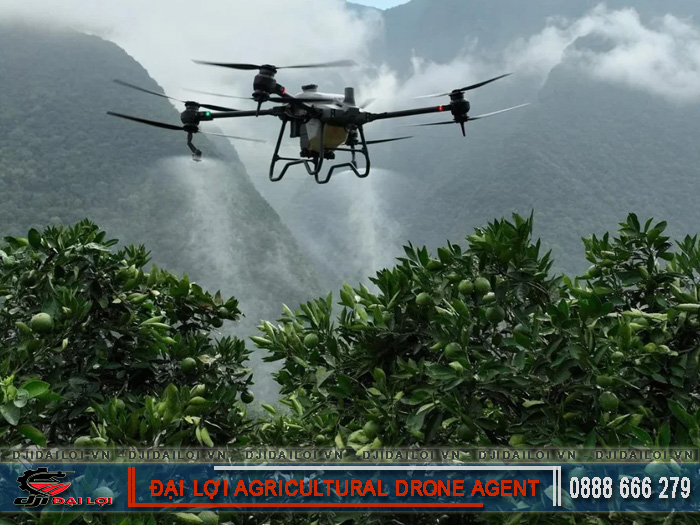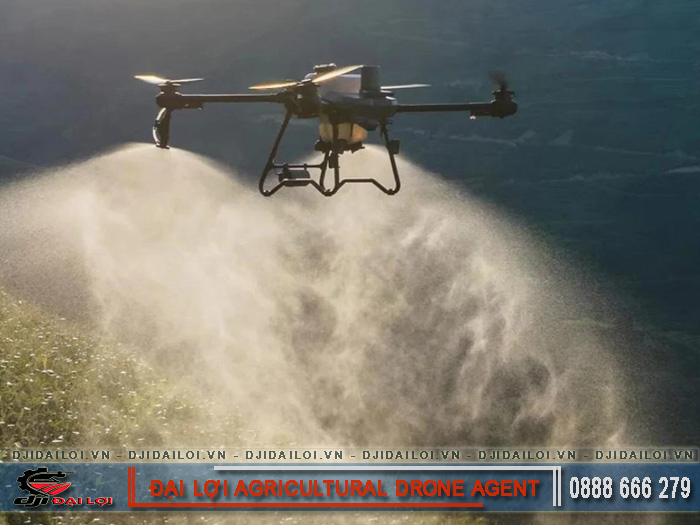
A pesticide spraying drone is an unmanned aerial vehicle (UAV) equipped with a liquid tank and an automated spraying system. It operates by dispersing fine mist over crops along GPS-programmed flight paths or under manual control.
The basic structure includes a flight frame, liquid tank, spray nozzles, sensors, and a GPS navigation system for precise targeting.
Today, popular agricultural drone brands such as DJI Agras, XAG, and Hylio are widely used across various crops - from rice and corn to sugarcane and fruit trees.
Thanks to these advantages, pesticide spraying drones are becoming an essential tool in modern agricultural production.
A single operator using a pesticide spraying drone can spray 10–20 hectares per day, compared to only 1–2 hectares by hand. This helps farmers save significant time and labor expenses, especially during peak seasons.
Ultra-fine mist technology ensures even coverage on leaves, reducing waste and saving 20–30% of chemicals. Crops are evenly protected, pest rates drop sharply, and yields increase noticeably.
Drones prevent direct human exposure to toxic chemicals while controlling spray volume precisely, minimizing drift into air and water - contributing to ecological protection.
Modern pesticide spraying drones can integrate with smart mapping software, allowing farmers to monitor spraying data, plan field operations, and easily expand cultivation to dozens of hectares without additional manpower.
A high-quality pesticide spraying drone typically costs between 150–300 million VND (approx. USD 6,000–12,000), excluding batteries and maintenance - posing a challenge for smallholder farmers.
Operators must be trained in flight control, spray calibration, and routine maintenance. Incorrect operation can cause malfunctions or safety risks during flight.
Drones perform best in dry, calm weather. Strong winds, rain, or uneven terrain may affect spray accuracy and flight stability.
Under current regulations, agricultural drone users must register their equipment and obtain flight permits. This ensures aviation safety and legal compliance.
→ Productivity increases 5–10 times, especially during peak farming periods.
Drones reduce pesticide use by 20–30% while achieving more uniform coverage and lower pest recurrence rates.
Although drones require higher upfront investment, farmers can recover costs within 1–2 crop seasons thanks to savings in labor and chemical use. Maintenance costs remain relatively low.
Drones minimize exposure to harmful chemicals and can operate in dangerous or hard-to-reach areas such as flooded fields and sloped terrains.
Investing in pesticide spraying drones helps reduce labor, save on chemical use, and improve yields. Farmers often recover their investment within 1–2 crop cycles, gaining 15–25% higher profits than with manual spraying.

|
Brand |
Tank capacity |
Key advantages |
Price range (VND) |
|---|---|---|---|
|
DJI Agras |
10–100 L |
Stable, efficient, user-friendly |
95–239 million |
|
XAG |
15–25 L |
High precision, chemical-saving |
160–250 million |
|
Hylio |
20–30 L |
Excellent performance, easy maintenance |
190–300 million |
Cooperatives in Dong Thap, An Giang, and Lam Dong have implemented pesticide spraying drones, reducing costs by 30% and increasing yields by over 20%.
Pesticide spraying drones are proving essential in digital agriculture transformation. Despite initial investment and technical challenges, they significantly reduce labor, boost productivity, and protect the environment.
Investing in pesticide spraying drones is not just a trend but a long-term profitable strategy. When chosen and managed properly, they empower farmers toward smart, sustainable, and high-yield farming - the inevitable path for modern agriculture.
Yes. In Vietnam, spraying drones are categorized as remotely controlled aircraft, requiring registration and authorization to ensure aviation safety.
Not recommended. Night operations reduce sensor accuracy and visibility. Some advanced models feature positioning lights and radar, but early morning or late afternoon flights are ideal for best results.
Typically, replace spray nozzles after 200–300 working hours and batteries after 250–350 charge cycles to maintain stable flight performance.
Yes, if equipped with terrain-following radar and altitude sensors, which stabilize spraying on hillsides and uneven fields like coffee or pepper farms.
Absolutely. Many providers offer full-service spraying at 35,000–60,000 VND per hectare, allowing farmers to experience modern technology without purchasing a drone.